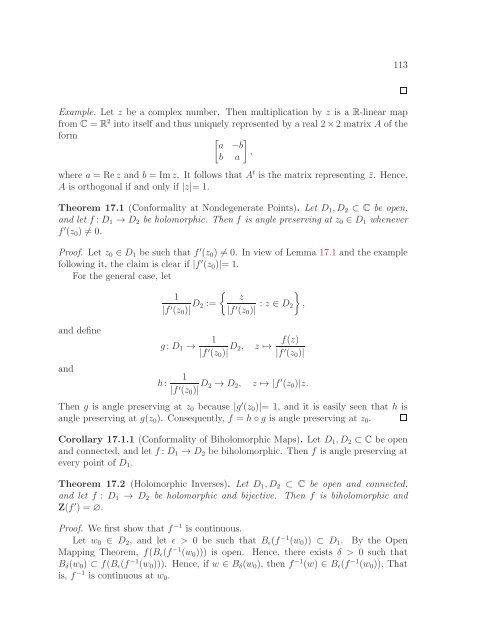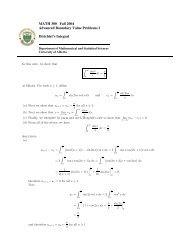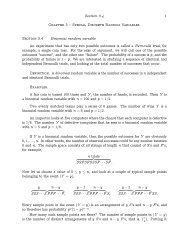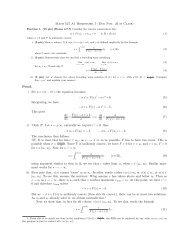Math 411: Honours Complex Variables - University of Alberta
Math 411: Honours Complex Variables - University of Alberta
Math 411: Honours Complex Variables - University of Alberta
You also want an ePaper? Increase the reach of your titles
YUMPU automatically turns print PDFs into web optimized ePapers that Google loves.
Example. Let z be a complex number. Then multiplication by z is a R-linear map<br />
from C = R2 into itself and thus uniquely represented by a real 2×2 matrix A <strong>of</strong> the<br />
form � �<br />
a −b<br />
,<br />
b a<br />
where a = Rez and b = Imz. It follows that A t is the matrix representing ¯z. Hence,<br />
A is orthogonal if and only if |z|= 1.<br />
Theorem 17.1 (Conformality at Nondegenerate Points). Let D1,D2 ⊂ C be open,<br />
and let f: D1 → D2 be holomorphic. Then f is angle preserving at z0 ∈ D1 whenever<br />
f ′ (z0) �= 0.<br />
Pro<strong>of</strong>. Let z0 ∈ D1 be such that f ′ (z0) �= 0. In view <strong>of</strong> Lemma 17.1 and the example<br />
following it, the claim is clear if |f ′ (z0)|= 1.<br />
For the general case, let<br />
and define<br />
and<br />
1<br />
|f ′ (z0)| D2<br />
�<br />
z<br />
:=<br />
|f ′ �<br />
: z ∈ D2 ,<br />
(z0)|<br />
g: D1 → 1<br />
|f ′ (z0)| D2, z ↦→ f(z)<br />
|f ′ (z0)|<br />
h:<br />
1<br />
|f ′ (z0)| D2 → D2, z ↦→ |f ′ (z0)|z.<br />
Then g is angle preserving at z0 because |g ′ (z0)|= 1, and it is easily seen that h is<br />
angle preserving at g(z0). Consequently, f = h◦g is angle preserving at z0.<br />
Corollary 17.1.1 (Conformality <strong>of</strong> Biholomorphic Maps). Let D1,D2 ⊂ C be open<br />
and connected, and let f: D1 → D2 be biholomorphic. Then f is angle preserving at<br />
every point <strong>of</strong> D1.<br />
Theorem 17.2 (Holomorphic Inverses). Let D1,D2 ⊂ C be open and connected,<br />
and let f : D1 → D2 be holomorphic and bijective. Then f is biholomorphic and<br />
Z(f ′ ) = ∅.<br />
Pro<strong>of</strong>. We first show that f −1 is continuous.<br />
Let w0 ∈ D2, and let ǫ > 0 be such that Bǫ(f −1 (w0)) ⊂ D1. By the Open<br />
Mapping Theorem, f(Bǫ(f −1 (w0))) is open. Hence, there exists δ > 0 such that<br />
Bδ(w0) ⊂ f(Bǫ(f −1 (w0))). Hence, if w ∈ Bδ(w0), then f −1 (w) ∈ Bǫ(f −1 (w0)), That<br />
is, f −1 is continuous at w0.<br />
113







